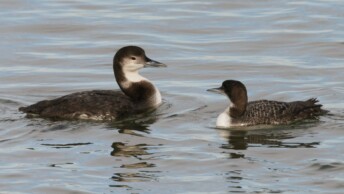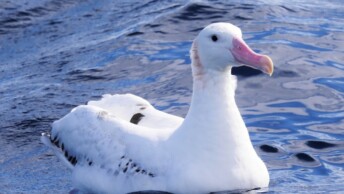The Andean condor (Vultur gryphus) is one of the largest birds in the world and a defining symbol of South America’s Andean landscapes. A master of soaring flight, it glides effortlessly for hours above mountain ridges and coastal cliffs, searching for carrion that sustains both it and the ecosystems it cleans.
Remarkably long-lived and slow to reproduce, the species is well adapted to stable environments but remains highly sensitive to human pressures, making its conservation a continuing challenge across the Andes.
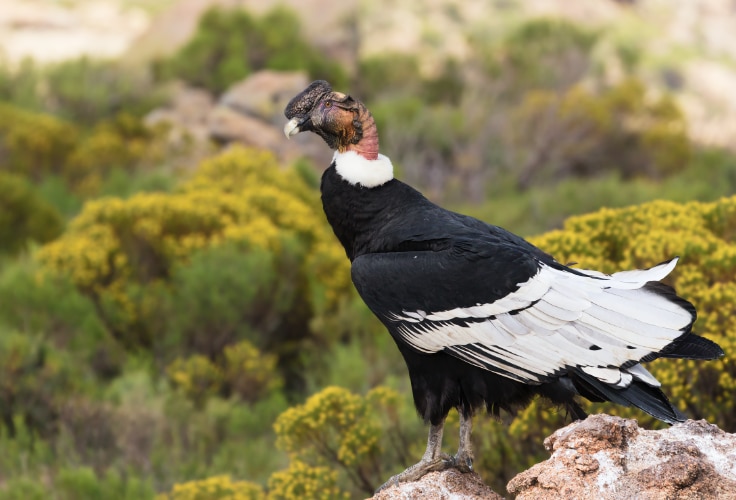
| Common name | Andean Condor |
| Scientific name | Vultur gryphus |
| Alternative names | Argentine condor, Bolivian condor, Chilean condor, Colombian condor, Ecuadorian condor, or Peruvian condor |
| Order | Accipitriformes (Cathartiformes) |
| Family | Cathartidae |
| Genus | Vultur |
| Discovery | Formally described by Linnaeus in 1758; known from much earlier indigenous and historical accounts across the Andes |
| Identification | Massive black vulture with white neck ruff and pale upperwing bands; bare reddish head and neck; males larger with a comb and wattles; juveniles brown with dark bare skin and duller plumage |
| Range | Andes from Venezuela and Colombia south to Tierra del Fuego; also in the Santa Marta Mountains of Colombia; locally descends to coastal plains of Peru and Chile |
| Migration | Non-migratory; resident year-round but covers vast distances daily in search of carrion |
| Habitat | High Andean zones; prefers open grasslands, cliffs, and ridges for roosting; also forages along coastal deserts and lowland plains |
| Behavior | Diurnal, highly social at roosts and carcasses; maintains hierarchical dominance led by adult males; capable of soaring for hours with minimal wingbeats |
| Breeding | Monogamous pairs nest on cliff ledges; single egg laid every 1-2 years; both sexes incubate; chick fledges at 6 months but remains dependent for several more |
| Lifespan | Around 50-60 years in the wild; may exceed 70 under favorable conditions; longest recorded age 79 years in captivity |
| Diet | Obligate scavenger feeding mainly on carcasses of large mammals and marine species; diet now dominated by livestock in many areas |
| Conservation | Vulnerable (IUCN); estimated around 10,000 individuals, including 6,700 mature birds; main threats include poisoning, lead contamination, and shooting |
Discovery
Long before its formal scientific description, the Andean condor was well known across the high Andes. Indigenous civilizations such as the Nazca, Moche, and Inca represented it in rock art, textiles, and ceramics dating as far back as 2500 BCE, reflecting both familiarity and reverence. These depictions attest to the species’ cultural prominence in the Andes long before European naturalists encountered it.
The species was formally described by Carl Linnaeus in the 10th edition of his Systema Naturae (1758), where it received the binomial Vultur gryphus, a name that has remained unchanged since. The generic name Vultur derives directly from Latin vultur or voltur, meaning “vulture,” while the specific epithet gryphus comes from the Greek grupós, meaning “hook-nosed” – an allusion to the bird’s powerful, curved bill. The common name “condor” is adapted from the Quechua word kuntur, further emphasizing its deep Andean origin and cultural significance.
The Andean condor belongs to the family Cathartidae, a group comprising the New World vultures, and is currently placed either within the order Accipitriformes (alongside hawks and Old World vultures) or in a separate order, Cathartiformes, depending on the classification adopted. It is the only extant member of its genus Vultur, distinguished from the smaller Gymnogyps lineage that includes the California condor (G. californianus).
Taxonomic placement within higher orders has long been debated. Early authorities, noting similarities in behavior and morphology to storks, proposed that New World vultures were more closely related to Ciconiiformes (storks). Subsequent molecular and anatomical studies challenged this view. More recent research based on nuclear and mitochondrial DNA has suggested either a distant relationship to Accipitriformes or that Cathartidae merits its own order, Cathartiformes. The South American Classification Committee currently lists the family as incertae sedis, acknowledging uncertainty while noting that both placements remain plausible.
The fossil record of Vultur gryphus is sparse compared with that of the California condor and its extinct relatives. Pleistocene and Pliocene remains from Bolivia, initially described as a distinct paleosubspecies (V. gryphus patruus), are now generally considered to fall within the variation of the modern species. No fossil congeners distinct from the living Andean condor are currently recognized.
Identification
The Andean condor is one of the world’s largest flying birds. It reaches a body length of 100 to 130 centimeters (39.4 to 51.2 inches), with an impressive wingspan of 2.6 to 3.3 meters (8.5 to 10.8 feet), and weighs between 8 and 15 kilograms (17.6 to 33.1 pounds), ranking it among the heaviest of all flying species. Its enormous wings, broad and fingered at the tips, have the greatest surface area of any extant bird, allowing it to soar for hours with minimal wingbeats.

Adult plumage is predominantly glossy black, contrasted by a striking white ruff encircling the base of the neck and broad white bands on the wings, most visible in mature males. The bare head and neck vary in color from dull grayish pink to reddish tones, deepening to bright yellow or orange during displays or agitation. This ability to flush or pale rapidly reflects both mood and dominance, particularly during courtship or at feeding sites. The massive, hooked bill is adapted to tear carrion rather than to kill prey, while the relatively flat feet with blunt talons and an elongated middle toe are better suited for walking on rocky slopes than for grasping.

The species is unique among New World vultures in showing pronounced sexual dimorphism. The male bears a prominent fleshy comb (caruncle) atop the head and large neck wattles, features completely absent in females. Females are also smaller and lighter, averaging around 10 kilograms (22 pounds), while males average about 12.5 kilograms (27.6 pounds). Eye color differs as well: males and immature females have brown irises, whereas adult females develop deep reddish eyes. The male’s skin tones tend to be yellower, especially when aroused or dominant.

Young Andean condors undergo a slow and complex transformation before reaching their striking adult appearance. Chicks are covered in dense gray down and grow rapidly, attaining nearly adult body size long before they acquire mature coloration. Newly fledged birds are dull grayish-brown, with darker heads and necks and no trace of the white ruff. Their bare skin is dark and uncolored, and the bill appears uniformly black. Over successive years, the plumage gradually darkens through a series of molts; the white neck ruff and broad wing patches emerge only in the later stages of immaturity. Full adult plumage is typically achieved between 7 and 8 years of age, coinciding with sexual maturity.
Vocalization
The Andean condor is generally a silent species, lacking the well-developed syrinx typical of most birds. Its vocal repertoire is limited to low hissing, clucking, and rattling sounds, produced mainly during close interactions. Soft clucks are heard in courtship displays, while harsher hisses or staccato rattles occur during aggressive encounters or competition at carcasses. These non-musical vocalizations are often accompanied by expressive postures and changes in skin color, which serve an important role in visual communication within the species.
Range
The Andean condor is native to South America, where it ranges along nearly the entire length of the Andes Mountains and in a few isolated northern outposts. Its distribution extends from the Santa Marta Mountains and Sierra de Perijá in northern Colombia and northwestern Venezuela southward through Ecuador, Peru, Bolivia, Chile, and western Argentina to Tierra del Fuego at the continent’s southern tip.
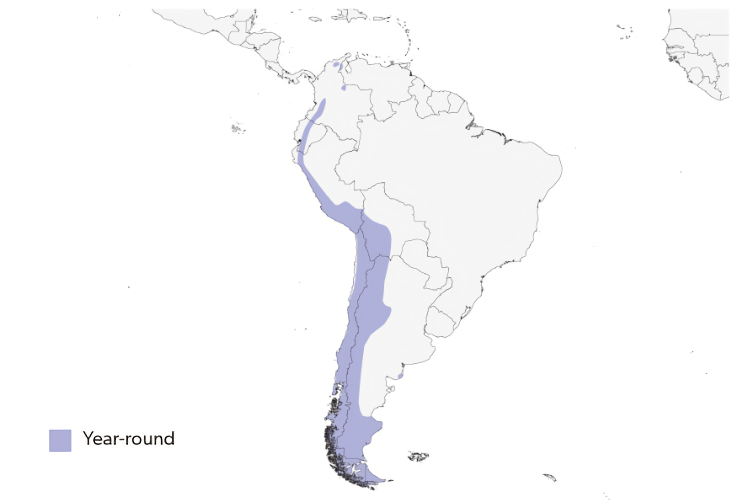
Historically, the species occurred continuously from Venezuela to Patagonia, but its range has contracted markedly in the northern Andes due to human persecution and habitat alteration. Today, stable breeding populations persist mainly in southern Peru, Chile, Argentina, and parts of Bolivia, while the species is rare or extirpated across much of Venezuela and Colombia.
Migration
Andean condors are largely sedentary and exhibit no true migration, although they cover vast areas while foraging. Individuals may travel hundreds of kilometers in a single day in search of carrion, especially in regions where food resources are unpredictable. Occasional wanderers have been recorded far from the main Andean range, including the Bolivian Chaco and lowland plains of northern Peru. Seasonal or altitudinal shifts are minimal, though local movements occur between breeding cliffs and feeding areas depending on carcass availability and weather conditions.
Habitat
The species inhabits open, sparsely vegetated landscapes, avoiding dense forests. Its primary environment consists of high mountain slopes, cliffs, and alpine grasslands, including the páramo and puna zones, often at elevations up to 5,000 meters (16,400 feet). These open habitats provide the strong updrafts required for soaring and clear visibility for locating carrion.
In southern South America, the condor is regularly seen above southern beech (Nothofagus) forests in Patagonia and uses adjacent meadows and plains where large herbivores, both wild and domestic, are present. The species also ventures to coastal deserts and lowland plains in Chile and Peru, where it feeds on the carcasses of stranded marine mammals and seabirds, and occasionally occupies offshore islands around Cape Horn.
Behavior
The Andean condor is a dominant scavenger and ecological apex species across much of its range. As the largest land bird capable of flight, it exerts strong influence over carrion resources in high Andean ecosystems, where few competitors exist.
Locomotion and Flight
Adapted for soaring, the condor’s flight performance is exceptional among birds. Its immense wings enable it to exploit even weak thermal updrafts along ridges and cliffs. Once aloft, it glides with wings held nearly horizontal and primaries slightly upturned at the tips. Modern bio-logging studies show that condors flap their wings only about 1% of the time, primarily during takeoff or when maneuvering near the ground, making them among the most energy-efficient flyers known.

One individual was recorded flying more than five hours and 172 kilometers (107 miles) without a single wingbeat. Mean gliding speeds average 14-15 m/s (50-54 km/h or 31-34 mph), though these vary with wind strength and altitude. The species usually roosts and nests on high ledges, allowing it to launch directly into updrafts with minimal effort.
Maintenance Behavior
The Andean condor also exhibits urohidrosis, a trait shared with other New World vultures. Individuals defecate on their own legs and feet, leaving a white coating of uric acid. This behavior is often interpreted as a cooling mechanism through evaporative heat loss, though its function in the cold, high-altitude environments inhabited by the species remains uncertain.
Social Structure and Interactions
Although Andean condors often travel singly or in pairs when soaring, they are notably social at communal roosts, nesting cliffs, and feeding sites. Groups can range from only a few individuals to more than fifty when large carcasses are available. Within these assemblages, a strict dominance hierarchy governs access to food and space: adult males dominate females and younger birds, with rank communicated through postures, lunges, and spread-wing displays rather than direct aggression. Changes in head and neck coloration, along with low clucking or hissing sounds, further signal dominance or submission. These visual and behavioral cues maintain group order and minimize conflict.
Social foraging also serves an important ecological role. By observing one another’s movements, condors can efficiently locate carcasses scattered over vast landscapes. Studies suggest that this information sharing improves scavenging success, especially at lower elevations where large livestock carcasses are more frequent. Thus, the species’ social organization reflects both its competitive dynamics and its cooperative efficiency as a large scavenger.
Relations with Humans and Other Threats
The Andean condor is largely free from natural predation due to its size and defensive strength. However, its interactions with humans have historically been ambivalent: it has been revered in Andean cultures as a sacred and protective figure, yet persecuted in recent centuries under the mistaken belief that it kills livestock, whereas in reality it primarily scavenges on carcasses. Today, deliberate poisoning of carcasses, direct disturbance, and persecution in pastoral areas remain localized threats.
Breeding
The Andean condor is a monogamous species that forms stable pair bonds lasting for life. Breeding occurs at low frequency, typically once every two years, and in some cases only once every 15-18 months if nesting is successful. Sexual maturity is reached relatively late, at 5 to 6 years of age, which, combined with slow reproductive turnover, contributes to the species’ naturally low population growth rate.
The timing of breeding varies geographically: egg-laying takes place mainly between April and October in Colombia, February and June in Peru, and September to October in Chile, though pairs in some regions, such as Ecuador, may breed year-round. Each breeding cycle extends over 12 months or more, encompassing prolonged incubation, slow chick growth, and extended post-fledging dependence.
Courtship
Courtship displays are elaborate and dominated by the male, whose fleshy neck and comb flush bright yellow during display. He approaches the female with his neck extended and inflated, wings partially spread, and body held erect while emitting low hisses, clucks, and tongue clicks. Males often perform short hops or a slow “dance” with half-open wings, circling or bowing before the female.

Pairs maintain strong bonds through mutual preening and synchronized postures, and these ritualized behaviors are believed to reinforce mate fidelity as well as pair coordination. Courtship generally begins several months before egg-laying, coinciding with increased interaction around established nesting cliffs.
Nesting
Condors breed at high elevations, most commonly between 3,000 and 5,000 meters (9,800-16,400 feet), where they select inaccessible cliff ledges or shallow caves for nesting. These sites provide safety from mammalian predators and clear takeoff points. In regions lacking tall cliffs, such as coastal Peru, nests may be built in rocky crevices or shaded depressions against boulders.
The nest itself is minimal, consisting of a scrape or platform lined with a few sticks or debris, sometimes reused in successive breeding seasons. Long-term monitoring in Ecuador and Argentina has shown that pairs return repeatedly to favored cliffs, forming small nesting clusters where several pairs may occupy the same massif at different elevations.
Egg Laying and Incubation
A single bluish-white egg is laid per clutch, measuring roughly 7-10 centimeters (2.8-3.9 inches) in length and weighing around 280 grams (9.9 ounces). If the egg or chick is lost, pairs are capable of laying a replacement egg, a trait that has been used in managed breeding programs to increase productivity.
Both sexes share incubation, which lasts approximately 54-60 days, though field observations suggest that males may spend longer periods at the nest. Adults are highly attentive and alternate duties smoothly, maintaining near-continuous coverage of the egg. Breeding records from the northern Andes indicate that incubation behavior and timing are consistent across regions despite climatic variation.
Hatching and Parental Care
The chick hatches covered in dense gray down and grows slowly, remaining in the nest for 6 to 10 months before fledging. Observations from Ecuador and Argentina confirm that males play a more active parental role, spending more time at the nest, feeding the chick more often, and remaining nearby after fledging. The female contributes mainly to incubation and protection during early development.
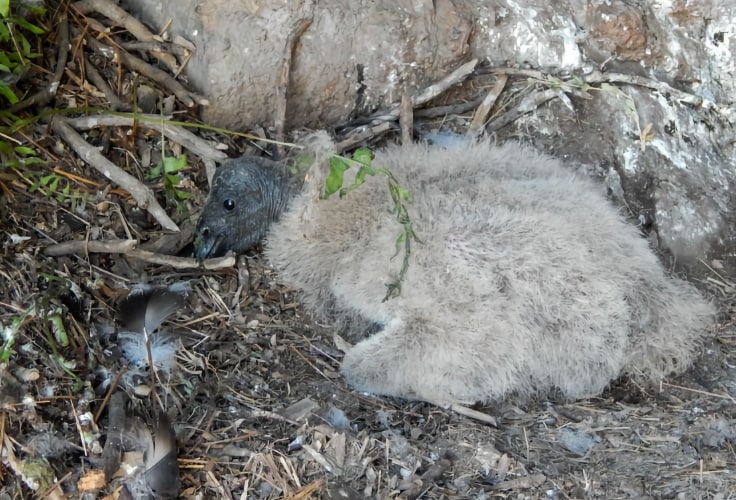
Even after the young take flight, typically at 6 months of age, they continue to roost and feed with their parents for up to 4 additional months, and family groups may persist until a new breeding attempt begins. In total, parental investment may extend well beyond a year, underscoring the species’ slow reproductive rhythm and dependence on stable environmental conditions for successful rearing.
Lifespan
The Andean condor is one of the longest-lived birds in the world, reflecting its slow life history and lack of natural predators. In the wild, longevity remains difficult to measure, but field estimates and banding records suggest that individuals routinely live beyond 50 years, with some believed to exceed 60 years under favorable conditions.
Captive data provide more precise figures: several individuals have lived over 70 years, and the longest verified case is Thaao, a male hatched in 1930 and kept at Beardsley Zoo (Connecticut, USA) until his death in 2010 at 79 years of age. Another long-lived individual, captured from the wild, survived 72 years in captivity, while others have reached 71 years. These exceptional lifespans underscore the species’ extremely slow aging and low reproductive turnover.
Survival and Mortality in the Wild
Longevity in the wild is balanced by relatively high juvenile mortality and a variety of human-related threats. Young birds face hazards from collisions and misadventure near cliffs, while fledglings in southern Chile are sometimes trapped soon after leaving the nest. Across the Andes, particularly in Ecuador, Colombia, and northern Peru, the dominant causes of recorded deaths are poisoning and shooting, which together account for the majority of known cases.
Between 1979 and 2021, at least 103 condors were poisoned and 22 shot in northern South America alone – losses representing up to 70% of some regional populations. In Chile, rehabilitation-center data indicate that over half of admitted birds were poisoned, and 13% collided with power lines; more than 70% carried shotgun pellets.
In parts of Peru, condors continue to be captured or injured during Yawar Fiesta celebrations, where they are tethered to bulls in traditional spectacles. Although such events are now less frequent, they still contribute to injury and mortality. Occasional mass poisoning incidents, such as the 2021 event in Bolivia that killed 35 condors, demonstrate the continuing vulnerability of the species to indirect persecution through contaminated carcasses meant for mammalian predators.
Adult Andean condors have very low natural mortality, and survivorship after fledging is thought to be among the highest of any large bird. However, the combined pressure of poisoning, collisions, and persecution has shifted this historically long-lived species toward anthropogenic mortality dominance in many regions. Given its exceptionally slow breeding cycle and low recruitment, even small increases in adult death rates can have severe population-level consequences.
Diet
The Andean Condor is an obligate scavenger, subsisting almost entirely on carrion. As the largest bird of prey in the world and the most powerful avian scavenger of South America, it dominates carcasses wherever it occurs. By efficiently removing carrion, the condor plays a crucial ecological role in maintaining ecosystem health and preventing the spread of disease.
Individuals travel vast distances each day, often exceeding 200 kilometers (124 miles), in search of food, relying primarily on sight and, in some cases, on the movements of smaller vultures that locate carcasses by smell. The condor’s massive bill enables it to tear through thick hides and access muscle and viscera that smaller scavengers cannot reach, making it a keystone species within Andean and Patagonian ecosystems.

The diet consists mainly of medium- and large-sized mammals, both wild and domestic. In inland regions, traditional food sources include guanacos, rheas, deer, and occasionally smaller mammals such as armadillos. However, the decline of native herbivores and the expansion of livestock have shifted the diet toward domestic ungulates – notably cattle, sheep, goats, horses, mules, and pigs.
Along the Pacific coast of Peru and Chile, condors feed heavily on marine mammal carcasses, including whales, sea lions, and seals, as well as seabirds and fish washed ashore. They also consume smaller prey when carrion is scarce, such as rodents, rabbits, or live birds, which they kill by repeated jabbing with the bill. Eggs from seabird colonies may occasionally supplement the diet. Feeding typically peaks during the middle of the day when rising thermals allow easy access to carcasses.
Condors feed communally at large carcasses, often with 10-40 birds present, though dominant males rarely tolerate other adult males at the same site. Interactions with other scavengers are complex: smaller Cathartes vultures (e.g., turkey and yellow-headed vultures) often locate carcasses first but must wait for condors to open them, while black vultures and mammalian scavengers yield to the condor’s superior size. In Patagonian ecosystems, condors are known to displace pumas from fresh kills, significantly reducing the cats’ feeding time and forcing them to increase kill rates – an example of a scavenger exerting top-down influence on a major predator.
Geographic and Temporal Variations
Modern studies have revealed clear regional and temporal shifts in the Andean condor’s diet, largely driven by human landscape modification. Across Chile and Argentina, condors now depend predominantly on introduced and domestic mammals, with livestock accounting for over 95% of prey items in some areas. In central Chile, individuals exhibit broader isotopic niches linked to anthropogenic resources such as landfills and corn-fed livestock, while condors in southern and austral zones feed mainly on free-ranging livestock and feral herbivores.
Historically, coastal populations relied heavily on marine subsidies, feeding on stranded whales and pinnipeds. Isotopic evidence shows that this component has declined sharply, from roughly one-third of the diet in the 19th century to less than 10% today, due to the reduction of marine mammal populations and increased human coastal activity. Despite this decline, many condors still nest near the coast and may fly over 80 kilometers (50 miles) inland to feed on terrestrial carcasses.
The species’ continued dependence on livestock and anthropogenic food sources provides short-term stability but increases exposure to poisoning, contaminants, and habitat disturbance, underscoring the conservation importance of maintaining safe and reliable food resources across its range.
Culture
The Andean condor has held profound symbolic importance across South America for millennia. Depicted in pottery, textiles, and rock art since at least 2500 BCE, it was revered by ancient Andean civilizations as a sacred messenger between the earthly and celestial realms. In Incan cosmology, the condor represented the upper world (Hanan Pacha) and was associated with the sun deity, symbolizing power, vitality, and renewal. Its feathers and bones were used in rituals and traditional medicine, reflecting beliefs in the bird’s healing and spiritual strength.
Today, the Andean condor remains a national symbol of Argentina, Bolivia, Chile, Colombia, Ecuador, Peru, and Venezuelan Andean states, and serves as the national bird of several of these countries. It features prominently on flags, coats of arms, stamps, coins, and banknotes, embodying freedom and endurance. In modern times, however, cultural practices such as the Yawar Fiesta – a traditional Peruvian celebration where a condor is tied to a bull, have drawn criticism for their impact on the species.
Across the Andes, the condor continues to represent both heritage and hope: a powerful emblem of indigenous identity and a reminder of the region’s deep ecological and spiritual connection to the mountains it so effortlessly commands.
Threats and Conservation
The Andean condor is currently classified as Vulnerable on the IUCN Red List. Although the species remains widely distributed along the Andes, it is naturally scarce and now undergoing a continuing population decline. The global population is estimated at roughly 10,000 individuals, equivalent to about 6,700 mature birds, though recent assessments suggest this may represent an upper limit.
Regional estimates highlight severe fragmentation: the species is now nearly extirpated from Venezuela, with occasional wanderers from Colombia, where only about 130 individuals remain. Ecuador supports approximately 150 birds, Peru 150-250, and Bolivia around 1,400. The largest populations occur farther south, with Chile and Argentina each holding up to 2,000 individuals, though there is likely some overlap between these estimates. The most robust subpopulation, roughly 300 individuals, including about 200 adults, is found in northwestern Patagonia.
Despite the condor’s long-distance flight capacity, genetic studies indicate restricted gene flow between regional populations, suggesting the presence of several partially isolated subpopulations, each likely containing fewer than 1,000 mature birds.
Overall, the species is thought to be declining at a rate of 30-49% over three generations (around 87 years), driven primarily by human-related mortality and environmental contamination. Its exceptionally slow reproduction and low natural mortality make it particularly vulnerable to even small increases in adult death rates.
Main Threats
The Andean condor’s life history, characterized by late maturity, low fecundity, and high adult survival, renders it extremely sensitive to additional mortality. The principal threats are poisoning, shooting, and lead contamination.
Mass poisonings have been recorded repeatedly across the Andes, including large-scale incidents in Argentina, Bolivia, Peru, and Colombia, often resulting from the illegal poisoning of carcasses intended for mammalian predators such as pumas and foxes. In northern South America, at least 225 condors were reported injured or killed between 1979 and 2021, with over 100 confirmed poisoning cases. In Chile, more than 50% of admitted condors to rehabilitation centers showed poisoning symptoms, while 72% carried shotgun pellets.
Lead poisoning from ingestion of bullet fragments in carcasses is now recognized as widespread across the range, posing a chronic and often fatal threat. Other hazards include collisions with power lines and communication towers, illegal capture for folkloric events such as the Yawar Fiesta in Peru, and occasional use in the illegal pet and wildlife trade.
Habitat conversion for agriculture and forestry reduces foraging habitat and may alter carrion availability. The species’ increasing dependence on livestock carcasses exposes it to veterinary toxins and changing agricultural practices. In some areas, competition with expanding black vulture populations and feral dogs further limits access to food. Though direct attacks on livestock are extremely rare, representing less than 1% of recorded livestock deaths, such incidents have perpetuated misconceptions and triggered persecution in pastoral areas.
Conservation Efforts
The Andean condor is protected under CITES Appendix I and CMS Appendix II and has been legally safeguarded in most range countries for decades. The species was listed under the U.S. Endangered Species Act in 1970 and recognized as Vulnerable globally in 2020 following improved threat assessments.
Extensive monitoring and reintroduction programs have been established since the late 1980s. The Andean Condor Conservation Program (PCCA) in Argentina has successfully reintroduced more than 160 individuals across South America using techniques that minimize human imprinting during rearing. Similar efforts in Colombia, Venezuela, and Chile have bolstered local populations with captive-bred birds. Released individuals are acclimated in pre-release aviaries and tracked by satellite to assess survival and dispersal.
Research and conservation efforts have intensified through genetic, isotopic, and telemetry studies, identifying critical roosting and nesting sites and guiding the delineation of 21 Andean Condor Conservation Units (ACCUs) – priority zones covering 37% of the species’ historical range. Conservation actions focus on habitat protection, regulating poison use, environmental education, and strengthening anti-poaching and wildlife trade laws.
Future Outlook
Despite important progress in research, reintroduction, and public awareness, the Andean condor’s recovery remains fragile. Effective conservation will depend on reducing human-induced mortality, particularly from poisoning and lead contamination, and on securing reliable, uncontaminated food sources across its range. Maintaining connectivity between regional subpopulations is equally critical to preserving genetic diversity and long-term viability. Sustained collaboration among governments, conservation organizations, and Andean communities will be essential to ensure that this emblematic species continues to soar over the mountains that have defined its existence for millennia.

